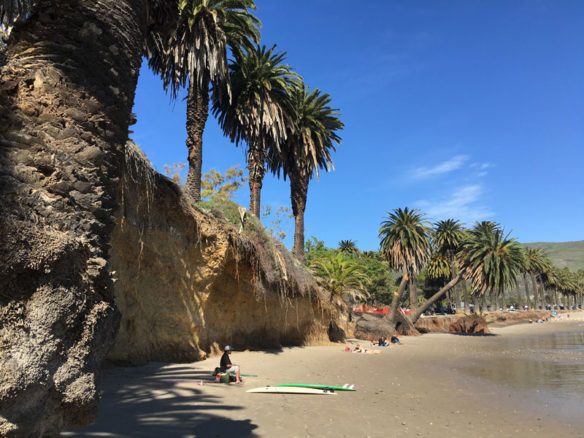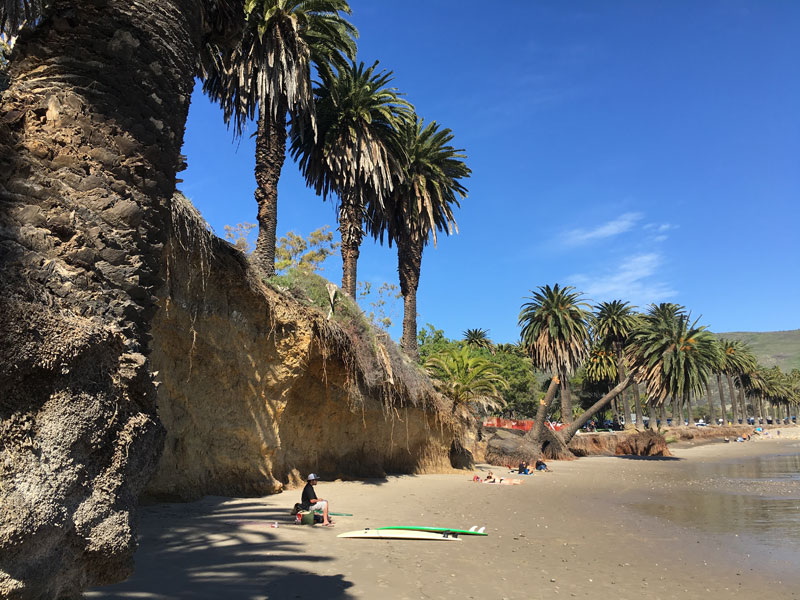
Refugio beach erosion, February 2016. Refugio State Beach is one of the true gems of the Gaviota Coast, 20 miles west of Santa Barbara, California. Photo: © SAF – Coastal Care
By USGS;
In a study released today, U.S. Geological Survey scientists and their colleagues document how the 2015-16 winter featured one of the most powerful El Niño climate events of the last 145 years.
Investigating 29 beaches along the U.S West Coast from Washington to southern California, researchers found that winter beach erosion was 76 percent above normal, by far the highest ever recorded, and most beaches in California eroded beyond historical extremes. If severe El Niño events such as this one become more common in the future as studies suggest, this coastal region, home to more than 25 million people, will become increasingly vulnerable to coastal hazards, independently of projected sea level rise.
The authors assessed seasonal changes on 29 beaches along approximately 2000 kilometers (1243 miles) of the U.S. West Coast. Surveying the beaches included making 3-D surface maps and cross-shore profiles using aerial lidar (light detection and ranging), GPS topographic surveys, and direct measurements of sand levels, combined with wave and water level data at each beach, collectively spanning 1997-2016. Winter beach erosion or the removal and loss of sand from the beach is a normal seasonal process, but the extent of erosion can be more severe during El Niño events than in other years.
“Wave conditions and coastal response were unprecedented for many locations during the winter of 2015-16. The winter wave energy equaled or exceeded measured historical maximums along the U.S. West Coast, corresponding to extreme beach erosion across the region,” said USGS geologist and lead author of the report, Patrick Barnard.
The 2015-16 El Niño was one of the three strongest events ever recorded, along with El Niño winters of 1982-83 and 1997-98. While most beaches in California eroded beyond historical extremes, some beaches fared better. “The condition of the beach before the winter of 2015 strongly influenced the severity of erosion and the ability of the beach to recover afterward through natural replenishment processes,” said UC Santa Barbara marine ecologist and co-author David Hubbard.
Rivers still supply the primary source of sand to California beaches, despite long-term reductions in the 20th century due to extensive dam construction. But as California is in the midst of a major drought, the resulting lower river flows equated to even less sand being carried to the coast to help sustain beaches.
“From a water resources perspective, this El Niño was largely considered a dud due to the unusually low rainfall, particularly in Southern California, which received 70 percent less rainfall than in the last two big El Niños. However, the waves that attacked our coast, generated from storms across the North Pacific, were exceptional and among the largest ever recorded,” said Barnard. “Further, the lack of rainfall means the coastal rivers produced very little sand to fill in what was lost from the beaches, so recovery has been slow.”
According to Scripps Institution of Oceanography co-author Bonnie Ludka, “Artificial beach nourishments (mechanically imported sand) placed prior to the winter of 2015-16 also protected some Southern California shorelines from retreating beyond landward extremes.” Unlike California, many of the Pacific Northwest beaches had been gaining sediment in the years leading up to the 2015-16 El Nino, due, at least in part, to a series of mild winter storm seasons that prevented these beaches from eroding to such extremes.
Although Pacific Northwest beaches were buffered from catastrophic damage, study co-author and Oregon State University coastal hazards expert Peter Ruggiero said, “several beaches did experience significant retreat and it may take a while for those beaches to rebuild. We’re not completely recovered yet and it may take years for some beaches to build back up. After the 1997-98 El Niño, it took some beaches a decade to recover.”
The full report, “Extreme oceanographic forcing and coastal response due to the 2015-16 El Niño,” was published online today in the journal “Nature Communications.”
Original Article And Learn More, USGS (02-14-2017)
Beach Bashing; UCSB Current News (02-14-2017)
New research conducted by U.S. Geological Survey (USGS) scientists and their colleagues at UC Santa Barbara and six other institutions found that during the 2015-16 El Niño winter beach erosion on the Pacific coast was 76 percent above normal, and that most beaches in California eroded beyond historical extremes…









